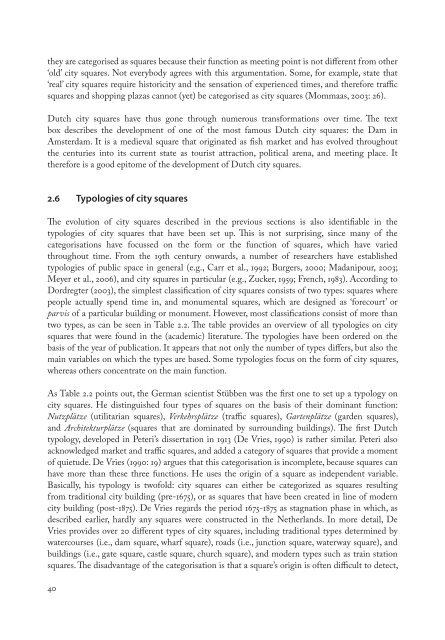Changing public space
Changing public space
Changing public space
Create successful ePaper yourself
Turn your PDF publications into a flip-book with our unique Google optimized e-Paper software.
they are categorised as squares because their function as meeting point is not different from other<br />
‘old’ city squares. Not everybody agrees with this argumentation. Some, for example, state that<br />
‘real’ city squares require historicity and the sensation of experienced times, and therefore traffic<br />
squares and shopping plazas cannot (yet) be categorised as city squares (Mommaas, 2003: 26).<br />
Dutch city squares have thus gone through numerous transformations over time. The text<br />
box describes the development of one of the most famous Dutch city squares: the Dam in<br />
Amsterdam. It is a medieval square that originated as fish market and has evolved throughout<br />
the centuries into its current state as tourist attraction, political arena, and meeting place. It<br />
therefore is a good epitome of the development of Dutch city squares.<br />
2.6 Typologies of city squares<br />
The evolution of city squares described in the previous sections is also identifiable in the<br />
typologies of city squares that have been set up. This is not surprising, since many of the<br />
categorisations have focussed on the form or the function of squares, which have varied<br />
throughout time. From the 19th century onwards, a number of researchers have established<br />
typologies of <strong>public</strong> <strong>space</strong> in general (e.g., Carr et al., 1992; Burgers, 2000; Madanipour, 2003;<br />
Meyer et al., 2006), and city squares in particular (e.g., Zucker, 1959; French, 1983). According to<br />
Dordregter (2003), the simplest classification of city squares consists of two types: squares where<br />
people actually spend time in, and monumental squares, which are designed as ‘forecourt’ or<br />
parvis of a particular building or monument. However, most classifications consist of more than<br />
two types, as can be seen in Table 2.2. The table provides an overview of all typologies on city<br />
squares that were found in the (academic) literature. The typologies have been ordered on the<br />
basis of the year of <strong>public</strong>ation. It appears that not only the number of types differs, but also the<br />
main variables on which the types are based. Some typologies focus on the form of city squares,<br />
whereas others concentrate on the main function.<br />
As Table 2.2 points out, the German scientist Stübben was the first one to set up a typology on<br />
city squares. He distinguished four types of squares on the basis of their dominant function:<br />
Nutzplätze (utilitarian squares), Verkehrsplätze (traffic squares), Gartenplätze (garden squares),<br />
and Architekturplätze (squares that are dominated by surrounding buildings). The first Dutch<br />
typology, developed in Peteri’s dissertation in 1913 (De Vries, 1990) is rather similar. Peteri also<br />
acknowledged market and traffic squares, and added a category of squares that provide a moment<br />
of quietude. De Vries (1990: 19) argues that this categorisation is incomplete, because squares can<br />
have more than these three functions. He uses the origin of a square as independent variable.<br />
Basically, his typology is twofold: city squares can either be categorized as squares resulting<br />
from traditional city building (pre-1675), or as squares that have been created in line of modern<br />
city building (post-1875). De Vries regards the period 1675-1875 as stagnation phase in which, as<br />
described earlier, hardly any squares were constructed in the Netherlands. In more detail, De<br />
Vries provides over 20 different types of city squares, including traditional types determined by<br />
watercourses (i.e., dam square, wharf square), roads (i.e., junction square, waterway square), and<br />
buildings (i.e., gate square, castle square, church square), and modern types such as train station<br />
squares. The disadvantage of the categorisation is that a square’s origin is often difficult to detect,<br />
40




